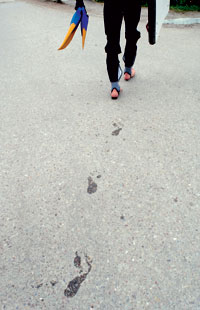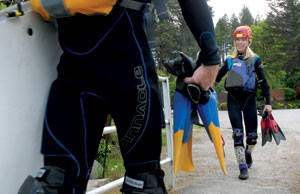On the morning of June 21, three Montanans and a Missourian will wake early, throw on their backpacks and begin a journey that will take them 500 miles through the mountains in 10 days or fewer, while climbing 100,000 vertical feet.
That’s the equivalent of traveling from Kalispell to Seattle and scaling Mount Everest three times in between, with another mountain still left to be climbed. Sometimes they’ll have companions like bikes and riverboards and climbing gear, but the rest of the time it’s just their feet.
Kristen Fredericks, one of team Big Sky/Flathead Beacon’s four members participating in the grueling endurance race called Primal Quest Montana, doesn’t pay too much attention to statistics and measurements.
“They’re all just numbers and they don’t mean anything,” the 39-year-old mother of three said. “When you’re going, you’re going, and when you’re not climbing anymore, you’re not climbing anymore.”
 |
|
Darin Fredericks leaves wet footprints as he crosses the road in Bigfork while riverboarding the Swan River. Darin and his wife, Kristen Fredericks, were practicing for the 10-day Primal Quest Montana race. |
Fredericks and her husband Darin, who live in Bigfork, have teamed together with their long-time endurance racing partner Andrew Matulionis, a pharmacist in Whitefish, and Thomas Etter, a doctor from Missouri. This year’s Primal Quest, which is a human endurance race that is considered the most challenging in the world, will be held in Gallatin County and officially lasts 10 days, though the faster teams will finish in a shorter time, maybe a week.
Contestants expect to begin at Big Sky Resort, but the actual starting point and course route are kept secret until the day of the race.
Eighty-two coed, four-person teams are signed up. Participants will trek through the often-rugged terrain of south central Montana, mountain biking, climbing, orienteering, riverboarding, kayaking and trail running. Teams come from all over the world, from Norway to Ireland to Mexico.
Aside from Kristen, the rest of the Montana team’s members are in their 40s. But that certainly doesn’t mean they’re at a disadvantage to younger teams, they say. Matulionis, who frequently participates in ultramarathons of 100 miles or more, said a multi-faceted race of this magnitude requires as much planning, mental strength and problem solving as it does fitness. Experience matters. He said it takes discipline, mostly learned through practice, to allow another team to pass you while you’re working out logistics or recuperating.
“You come in there as a medium fitness team that has experience, that’s smart, knows how to pace themselves, doesn’t get lost, you probably will finish in that neighborhood of top 10,” Matulionis said.
For the Fredericks, part of the adventure is simply hopping on the riverboard for the first time. A riverboard is in the family of a surf or boogie board and rapidly scoots across a river’s rapids. Kristen has taken note of this year’s high water levels, making the normally exciting Gallatin River even rowdier.
The Fredericks have been practicing in the Swan River near where they live. Kristen, who was initially skeptical of the four-foot freshwater vessels, said they look harder than they really are.
“It’s almost like a ducky in a bath tub,” she said. “It goes over the rapids easily.”
 |
|
Darin Fredericks, left, and his wife, Kristen Fredericks, cross the swan river on Bridge Street before taking the first run of the afternoon on their riverboards. |
Kristen and Darin own businesses in Bigfork and have three children, which often leaves little time for training. So they do what they can, hopping on bikes even if only for a few minutes, running when they get the slightest sliver of an opening and throwing the boards in the water when the weekends allow. Kristen owns a Pilates business while Darin runs an eco-building construction company.
Their schedules provide ample practice for time management, a key aspect of endurance racing. One of the harshest realities of this time management is the toll it takes on sleeping patterns. Trying to maximize every minute, racers often rely on catnaps, going up to 40 hours straight without sleep. Kristen is betting on only one-and-a-half hours per night – or day. Matulionis is hoping for an average of two hours of sleep everyday, with hopeful stretches of up to 3 hours at a time.
“A lot of little catnaps – 15 or 20 minutes in the warm sun does amazing things to rejuvenate yourself,” Matulionis said. “But if you push it too much it’s just going to come back and bite you.”
Food management is less of a painstaking process, Matulionis said. The basic theory is chow down whenever you’re hungry and you’ll burn it off. Normally more selective in his everyday eating habits, Matulionis described his “four basic food groups” while racing: sugar, salt, caffeine and fat. He’s joking, but only slightly.
“A lot of junk food, supplements a bit,” he said. “When you have a race of this length you have to be eating meals, things that taste good – bacon and eggs and toast and tons of butter; burritos full of beans and meat.”
Though the Fredericks frequently enter endurance races, the longest have been closer to 300 or 350 miles, Kristen said. This is their biggest.
“We’ve always been keeping our finger in the pie a little bit, but nothing major like this,” Darin said. “This is the grand daddy of adventure races at this point.”